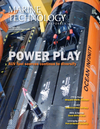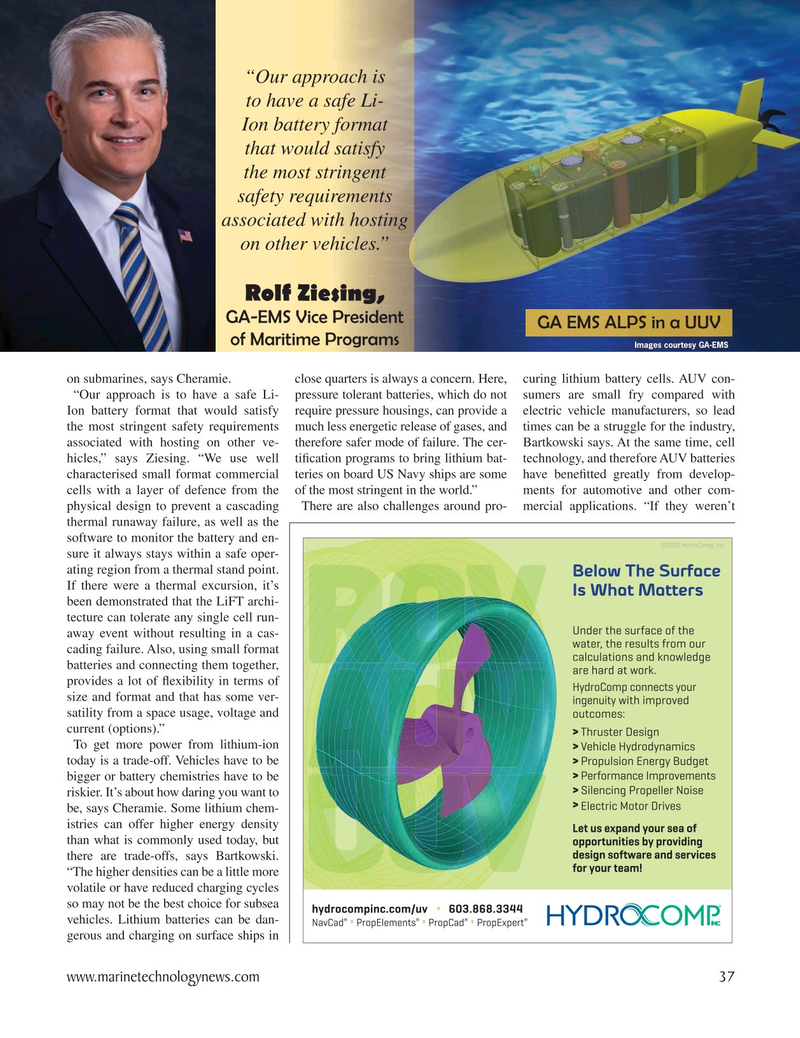
Page 37: of Marine Technology Magazine (July 2022)
Read this page in Pdf, Flash or Html5 edition of July 2022 Marine Technology Magazine
“Our approach is to have a safe Li-
Ion battery format that would satisfy the most stringent safety requirements associated with hosting on other vehicles.”
Rolf Ziesing,
GA-EMS Vice President
GA EMS ALPS in a UUV of Maritime Programs
Images courtesy GA-EMS on submarines, says Cheramie. close quarters is always a concern. Here, curing lithium battery cells. AUV con- “Our approach is to have a safe Li- pressure tolerant batteries, which do not sumers are small fry compared with
Ion battery format that would satisfy require pressure housings, can provide a electric vehicle manufacturers, so lead the most stringent safety requirements much less energetic release of gases, and times can be a struggle for the industry, associated with hosting on other ve- therefore safer mode of failure. The cer- Bartkowski says. At the same time, cell hicles,” says Ziesing. “We use well ti? cation programs to bring lithium bat- technology, and therefore AUV batteries characterised small format commercial teries on board US Navy ships are some have bene? tted greatly from develop- cells with a layer of defence from the of the most stringent in the world.” ments for automotive and other com- physical design to prevent a cascading There are also challenges around pro- mercial applications. “If they weren’t thermal runaway failure, as well as the software to monitor the battery and en- ©2022 HydroComp, Inc.
sure it always stays within a safe oper- ating region from a thermal stand point.
Below The Surface
If there were a thermal excursion, it’s
Is What Matters been demonstrated that the LiFT archi- tecture can tolerate any single cell run-
Under the surface of the away event without resulting in a cas- water, the results from our cading failure. Also, using small format calculations and knowledge
R VU A R ROV V V batteries and connecting them together, are hard at work.
provides a lot of ? exibility in terms of
HydroComp connects your size and format and that has some ver- ingenuity with improved satility from a space usage, voltage and outcomes: current (options).” > Thruster Design
To get more power from lithium-ion > Vehicle Hydrodynamics today is a trade-off. Vehicles have to be > Propulsion Energy Budget U O U U VU VU V >
Performance Improvements bigger or battery chemistries have to be > Silencing Propeller Noise riskier. It’s about how daring you want to >
Electric Motor Drives be, says Cheramie. Some lithium chem- istries can offer higher energy density
Let us expand your sea of than what is commonly used today, but opportunities by providing design software and services there are trade-offs, says Bartkowski. for your team! “The higher densities can be a little more volatile or have reduced charging cycles so may not be the best choice for subsea hydrocompinc.com/uv 603.868.3344• ® ® ® ® vehicles. Lithium batteries can be dan-
NavCad PropElements PropCad PropExpert• • • gerous and charging on surface ships in www.marinetechnologynews.com 37
MTR #5 (34-49).indd 37 6/30/2022 1:22:57 PM

 36
36

 38
38
